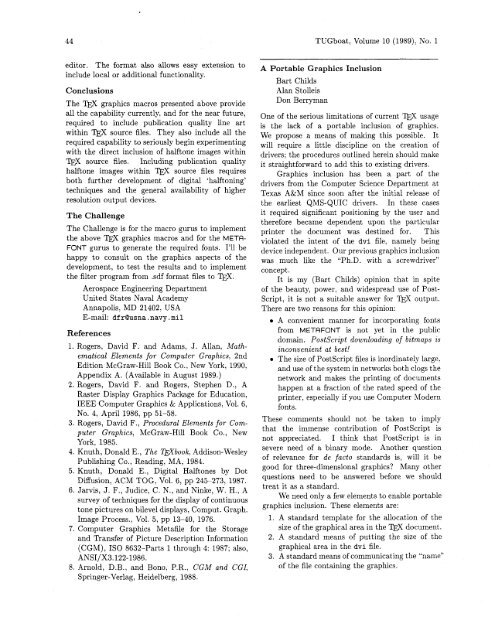Complete issue 10:1 as one pdf - TUG
Complete issue 10:1 as one pdf - TUG
Complete issue 10:1 as one pdf - TUG
Create successful ePaper yourself
Turn your PDF publications into a flip-book with our unique Google optimized e-Paper software.
<strong>TUG</strong>boat, Volume <strong>10</strong> (1989), No. 1<br />
editor. The format also allows e<strong>as</strong>y extension to<br />
include local or additional functionality.<br />
Conclusions<br />
The graphics macros presented above provide<br />
all the capability currently, and for the near future,<br />
required to include publication quality line art<br />
within source files. They also include all the<br />
required capability to seriously begin experimenting<br />
with the direct inclusion of halft<strong>one</strong> images within<br />
TEX source files. Including publication quality<br />
halft<strong>one</strong> images within source files requires<br />
both further development of digital 'halftoning'<br />
techniques and the general availability of higher<br />
resolution output devices.<br />
The Challenge<br />
The Challenge is for the macro gurus to implement<br />
the above TQX graphics macros and for the META-<br />
FONT gurus to generate the required fonts. I'll be<br />
happy to consult on the graphics <strong>as</strong>pects of the<br />
development, to test the results and to implement<br />
the filter program from .sdf format files to m.<br />
Aerospace Engineering Department<br />
United States Naval Academy<br />
Annapolis, MD 21402, USA<br />
E-mail: df rOusna .navy. mil<br />
References<br />
1. Rogers, David F. and Adams, J. Allan, Mathematical<br />
Elements for Computer Graphics, 2nd<br />
Edition McGraw-Hill Book Co., New York, 1990,<br />
Appendix A. (Available in August 1989.)<br />
2. Rogers, David F. and Rogers, Stephen D., A<br />
R<strong>as</strong>ter Display Graphics Package for Education,<br />
IEEE Computer Graphics & Applications, Vol. 6,<br />
No. 4, April 1986, pp 51-58.<br />
3. Rogers, David F., Procedural Elements for Computer<br />
Graphics, McGraw-Hill Book Co., New<br />
York, 1985.<br />
Knuth, Donald E., The Wbook, Addison-Wesley<br />
Publishing Co., Reading, MA, 1984.<br />
Knuth, Donald E., Digital Halft<strong>one</strong>s by Dot<br />
Diffusion, ACM TOG, Vol. 6, pp 245-273, 1987.<br />
Jarvis, J. F., Judice, C. N., and Ninke, W. H., A<br />
survey of techniques for the display of continuous<br />
t<strong>one</strong> pictures on bilevel displays, Comput. Graph.<br />
Image Process., Vol. 5, pp 13-40, 1976.<br />
Computer Graphics Metafile for the Storage<br />
and Transfer of Picture Description Information<br />
(CGM), IS0 8632-Parts 1 through 4: 1987; also,<br />
ANSIIX3.122-1986.<br />
Arnold, D.B., and Bono, P.R., CGM and CGI,<br />
Springer-Verlag, Heidelberg, 1988.<br />
A Portable Graphics Inclusion<br />
Bart Childs<br />
Alan Stolleis<br />
Don Berryman<br />
One of the serious limitations of current usage<br />
is the lack of a portable inclusion of graphics.<br />
We propose a means of making this possible. It<br />
will require a little discipline on the creation of<br />
drivers; the procedures outlined herein should make<br />
it straightforward to add this to existing drivers.<br />
Graphics inclusion h<strong>as</strong> been a part of the<br />
drivers from the Computer Science Department at<br />
Tex<strong>as</strong> A&M since soon after the initial rele<strong>as</strong>e of<br />
the earliest QMS-QUIC drivers. In these c<strong>as</strong>es<br />
it required significant positioning by the user and<br />
therefore became dependent upon the particular<br />
printer the document w<strong>as</strong> destined for. This<br />
violated the intent of the dvi file, namely being<br />
device independent. Our previous graphics inclusion<br />
w<strong>as</strong> much like the "Ph.D. with a screwdriver"<br />
concept.<br />
It is my (Bart Childs) opinion that in spite<br />
of the beauty, power, and widespread use of Post-<br />
Script, it is not a suitable answer for output.<br />
There are two re<strong>as</strong>ons for this opinion:<br />
rn A convenient manner for incorporating fonts<br />
from METAFONT is not yet in the public<br />
domain. PostScript downloading of bitmaps is<br />
inconvenient at best!<br />
rn The size of Postscript files is inordinately large,<br />
and use of the system in networks both clogs the<br />
network and makes the printing of documents<br />
happen at a fraction of the rated speed of the<br />
printer, especially if you use Computer Modern<br />
fonts.<br />
These comments should not be taken to imply<br />
that the immense contribution of PostScript is<br />
not appreciated. I think that Postscript is in<br />
severe need of a binary mode. Another question<br />
of relevance for de fncto standards is, will it be<br />
good for three-dimensional graphics? Many other<br />
questions need to be answered before we should<br />
treat it <strong>as</strong> a standard.<br />
We need only a few elements to enable portable<br />
graphics inclusion. These elements are:<br />
1. A standard template for the allocation of the<br />
size of the graphical area in the document.<br />
2. A standard means of putting the size of the<br />
graphical area in the dvi file.<br />
3. A standard means of communicating the "name"<br />
of the file containing the graphics.

















